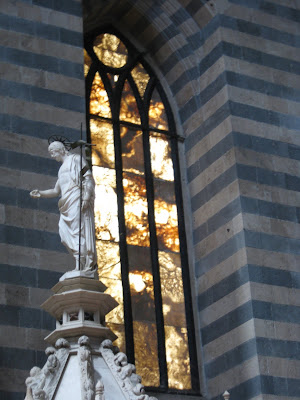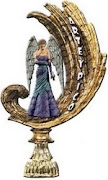In this post I'll describe the trip to Umbria that I took with my family last summer. You may not believe it, but I had never been to this wonderful Italian region before, even though many foreigners coming to my home country add at least a one-day tour to Assisi during their visit. So, I was very much looking forward to this trip.
Umbria is also known as 'the green heart of Italy', due to its location and its luxurious vegetation. We split our stay in two cities: Orvieto and Perugia. You can see where they are more precisely here:
We split our stay in two cities: Orvieto and Perugia. You can see where they are more precisely here: My mom found some bed and breakfasts in these two towns. I highly recommend this type of lodging if you're traveling to Italy with a group of people. The apartments are usually really nice, and they are unbelievably inexpensive compared to hotels. Plus, they have a kitchen, so you don't have to eat out every meal if you don't want to. This was the main room of our B&B in Orvieto. There were two more rooms, with a single and a double bed.
My mom found some bed and breakfasts in these two towns. I highly recommend this type of lodging if you're traveling to Italy with a group of people. The apartments are usually really nice, and they are unbelievably inexpensive compared to hotels. Plus, they have a kitchen, so you don't have to eat out every meal if you don't want to. This was the main room of our B&B in Orvieto. There were two more rooms, with a single and a double bed.

Here you can see it in its splendor over the city (look at the top center of the picture).







The whole city of Orvieto is a mix of Etruscan, Roman and Medieval remains. It was originally built by Etruscans, who were able to keep up with a siege by the Romans for three months. They survived thanks to wells that were dug all the way through the volcanic hill, reaching to the water at the bottom. A lot of wells are still visible. Look inside one of them and imagine the people digging out the dirt and going lower and lower, using the holes you see on the sidewalls as stairs.

One of the things I really enjoyed of Orvieto was its location. Surrounded by hills and lakes, it's the perfect place to start bike rides. I found out that, unlike in Japan, in Italy it's very easy to rent beautiful bikes for weeks at a time for very cheap. I got a carbon-frame race bike for 10 Euros a day, and I kept it for 4 days, as long as we were in Orvieto.
I went for my excursions in the late afternoon, after visiting places with my family.
I went twice to Bolsena lake. It's in Lazio, the region bordering Umbria (you can see it in the map at the beginning of the post). Depending on how much time you have, you can choose to get there going up and down only two hills or as many as you want. The hills are not extremely high (maximum ~600 m) but altogether they make for a good exercise. And the best part is obviously the landscape! Seeing Orvieto from far away, at the sunset, is just amazing (see the first pictures of this post). And every hill has vineyards, with a castle or a farm on top:

I went all the way down to the town of Bolsena during one of the bike trips. It's a really beautiful Medieval town, with the typical narrow streets.

I really enjoyed these bike rides. Biking is a great way to tour, I decided, and biking in Italy is particularly good: you see beautiful landscapes, and cross small towns filled with character and history, which are not too far from each other.. not to speak about the food and wine, of course! So I'm hoping I'll be able to go back in not too long, hopefully with Matt.
We went back to Bolsena lake with my parents and sister, to visit its southern part. We stopped for lunch at Montefiascone, another Medieval town on the hills. That day, people were parading in Medieval costumes. We arrived almost at the end of the parade, so here you can see one of the ladies resting with her hat off--it was very hot!
For lunch, I finally tried the stuffed pigeon, a specialty in Umbria.
Quite good, even though there's not a lot of meat. The stuffing was made with potatoes and olives.
For dessert, we had another typical food:
If you climb to the top of Montefiascone, you get a wonderful view of Bolsena lake and the surrounding hills.
After lunch, we drove to Marta. Yes, hard to believe, but there is a town called Marta on Bolsena Lake! So here is my favorite picture of Marta@Marta:
On another day we visited Todi. Todi is not a typical touristic destination in Umbria, but it's a fantastic Roman and Medieval town, with a relaxed atmosphere. Mmm... maybe I shouldn't advertise it or this quiet will be lost, eheh. It has a beautiful main square..









I still haven't shown pictures of my family! So, here are my sister and mom after lunch.

Before leaving Todi, here is a typical detail of this and all small towns in Italy: a beautiful belltower.
Todi was our last day trip from Orvieto. Then, we moved to Perugia, where we stayed in another really nice bed and breakfast right downtown. Perugia is much larger than Orvieto, and has really majestic and beautiful squares and buildings. This is Palazzo dei Priori (pretty much the town hall), as an example:


This first set of images comes from streets close to Corso Vannucci, the main promenade of the city. So, here is the touristic starting point, with the Palazzo dei Priori on the right, and the Fontana Maggiore (Major Fountain):


I found another interesting neighborhood past the church of San Pietro, close to the botanical garden: here the small church of San Costantino attracted my attention for this beautiful detail.
Another wonderful religious detail I saw was this piece of a fresco in front of Santa Maria di Monteluce:
And another area I really liked was the neighborhood surrounding the Tempio di Sant'Angelo, a round church with a quiet and majestic interior that reminded me of a Roman temple:



Food in Perugia is also quite nice. Here is a typical dessert, a snake made of almond paste, really good. I brought one back for Matt to taste, and he really liked it too.
We took two day-trips from Perugia. The first one was to Gubbio, stopping by Umbertide. We chose this mid-way stop because my dad's name is Umberto, so we really wanted to take a picture of him in this town like we did for me at Marta:
Gubbio was quite nice, even though maybe we didn't spend enough time to fully appreciate all its beauties, also because it started raining on us. This is the main street.

One thing we surely appreciated in Gubbio was the food. Again, we had an appetizer platter of salumi (a general term that includes salame and prosciutto of various kinds). I wouldn't be able to tell you the names of all of these salumi; Many of them are local and it would be hard to find them outside Umbria.


Our second day-trip was to Assisi and to the Trasimeno lake. Assisi was for sure the most touristic place we visited, even though luckily it wasn't too crowded when we went. The Basilica's frescoes are amazing, but I can show you here only the outside, which is also quite impressive.

I also enjoyed our final walk on the side of the Assisi hill, which allowed me to take a few pictures of the nature around, such as these olives against the sky:
Our final destination for the day was the Trasimeno lake. We went to Castiglione del lago, and enjoyed a late afternoon on the lake. This was also the final destination of my trip to Umbria with my family. I had to leave and go back to Berkeley, to pack everything up and get ready for the next adventure.
Take this picture of me on the Trasimeno lake as a warm goodbye from Italy and to Italy. It was a really nice trip, maybe the best my family and I took together. I hope you enjoyed reading about it, and I look forward to questions, comments, and seeing my family and Italy again!
Sunday, December 27, 2009
| [+/-] |
Viaggio in Umbria |
----------
Later addition: this post has been featured on 'Been in Umbria', a blog that shows experiences from tourists been in Umbria. Thanks, I feel very honored!
-----------
Subscribe to:
Posts (Atom)





















